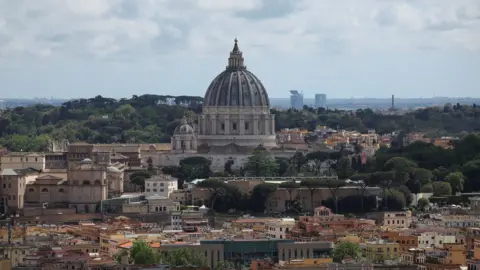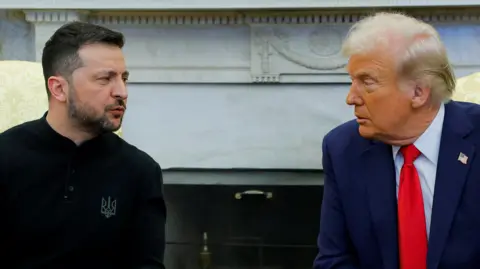Pope Francis's funeral presents chance for 'brush-by' diplomacy
 Reuters
ReutersWorld leaders may be gathering on Saturday to pay their respects to a fellow statesman whose church has more members than their states have citizens.
But they may also use the Pope's funeral as a rare and unexpected opportunity to conduct a little impromptu diplomacy.
For it will be one of the largest gatherings of global heads of state and government since the funeral of the late Queen in 2022.
Diplomats said there were few plans for formal meetings between government leaders because that would not be in the spirit of what is a solemn occasion.
"We do not want to be disrespectful to our hosts," one European diplomat said. "But will there be opportunities for brush-byes? Absolutely."
That was a reference to the serendipitous conversations that can take place on the margins of a summit or a ceremony as leaders "brush by" one another while they find their seats.
Another official said: "It's a funeral. We are treading carefully."
All eyes will, of course, be on whether Presidents Trump and Zelensky use the opportunity of being in the same place to discuss the prospects of a ceasefire in Ukraine. They will be seated in an area of St Peter's Square allocated to world leaders in alphabetical order by country.
You might imagine that means the leaders of the United States and Ukraine would sit near one another. But French was historically the language of diplomacy so the President of les États-Unis may well be some distance from his Ukrainian counterpart.
Given the tensions between the two leaders, some diplomats said this might be no bad thing and could avoid the risk of a confrontation like that in the Oval Office in February.
It is possible both men could meet privately elsewhere in Rome, as some European countries were hoping, but it was not clear if that was likely. "If it happens, it will be impromptu," one diplomat said.
On Tuesday, Zelensky said he was ready in principle to see Trump in Rome. "We are always ready to meet with our partners from the United State of America," he said.
The following day, Trump said he had "a lot of meetings set up" but did not say with whom. On Friday, Zelensky cast doubt on whether he would manage to attend after all, following the latest Russian strikes on Kyiv disrupting his travel plans.
 Reuters
ReutersThe diplomatic focus will be on the part of St Peter's Square where presidents and prime ministers, princes and monarchs will sit waiting for the obsequies to begin. That will be the main opportunity for them to mingle and discuss the issues of the day, to make contacts and establish relationships.
The journey to Rome could also provide an opportunity for diplomatic encounters. The Vatican said 170 delegations were coming including about 50 heads of state, 15 heads of government and 12 reigning monarchs. The chances of them meeting at one of Rome's two airports on arrival or departure is high.
But while funerals can present diplomatic opportunities, they can also pose threats. There is the possibility of leaders coming into contact with an adversary. That is because politicians who are subject to European travel sanctions can visit Vatican City because it is considered neutral territory. Crucially, neither President Vladimir Putin of Russia, nor President Xi Jinping of China are due to attend.
- You can watch and follow the funeral live here on the BBC News website and app. In the UK, there will be live coverage on BBC One from 0830-1230 BST, presented by Reeta Chakrabarti, available to watch on the iPlayer. There will also be live coverage on the BBC News channel presented by Maryam Moshiri. Finally, you can also follow coverage of the funeral on the BBC World Service
The most unpredictable moment could come in the service itself. Francis Campbell, the British ambassador to the Holy See from 2005 to 2011, said the funeral Mass involves a moment when celebrants give each other a sign of peace and leaders could find themselves shaking hands with people they would rather not. "You cannot avoid it," he said. "You are attending a religious ceremony and it's incumbent on you to participate as much as possible."
At the funeral of Pope John Paul II in 2005, the then Prince of Wales found himself unexpectedly shaking hands with President Robert Mugabe of Zimbabwe. The future King's spokesman said he had been "caught by surprise".
There are also risks for leaders appearing before many thousands of mourners. At the same funeral in 2005, George Bush was booed by the crowd when his face was displayed on a monitor, an apparent judgement on the US president's war in Iraq.
 Getty Images
Getty ImagesThe former Prime Minister Harold Wilson is credited with coining the phrase "a good working funeral" in relation to the service marking the death of Winston Churchill in 1965.
Geoff Berridge, Emeritus Professor of International Relations at Leicester University, said working funerals were of considerable value.
"They provide heads of state and government with a good excuse to break existing schedules for urgent discussions on current problems without arousing public expectations," he wrote in his book, Diplomacy: Theory and Practice.
In recent years, there have been several such funerals following the deaths of the late Queen, the former Japanese prime minister Shinzo Abe, and Ebrahim Raisi, the Iranian president.
But "working funerals" have also been the subject of satire. Jim Hacker, the eponymous PM in the Yes, Prime Minister comedy on the BBC, said working funerals were a "heaven sent" opportunity.
"Dignified grief goes down very well with the voters, especially when it is shared by the world's statesmen," he told his aides. Working funerals were "much better than a summit because there are no expectations. People don't expect their leaders to come back from a funeral with test ban agreements or farm quote reductions. So we can actually have some meaningful discussions. A summit is just a public relations circus."
